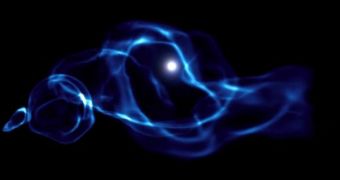A new series of computer simulations conducted by investigators at Princeton University and the New York University (NYU) reveals that dark matter could potentially form when a primordial black hole – a relic from the time of the Big Bang – passes through a star.
With these models, researchers tried to figure out how such a collision would appear in optical wavelengths. An important thing to remember here is that primordial black holes are very different from their modern, supermassive counterparts.
They are significantly smaller, and also incredibly old, nearly as old as the Universe itself. They are believed to have developed a brief time after the Big Bang rapidly expanded the Cosmos into being.
Thanks to the new study, astrophysicists now have access to a new method of detecting collisions between stars and primordial black holes. Investigating these events could provide experts with an additional insight into the nature of dark matter.
According to theory, this is the stuff that makes up for nearly a quarter of the Universe's mass-energy budget. It is not visible in any wavelength, since it does not readily interact with regular, baryonic matter. However, it does make its presence known through gravitational interactions.
One of the implications of Albert Einstein's Theory of General Relativity is that primordial black holes (themselves theoretical, never-actually-seen structures) share many of the properties experts usually associate with dark matter, and may even be made out of the stuff.
In fact, it may be that this elusive type of black hole is a source of dark matter, say Shravan Hanasoge, a postdoctoral researcher at the Princeton Department of Geosciences, and Michael Kesden, a postdoctoral researcher with the NYU Center for Cosmology and Particle Physics.
Given that the Milky Way has about 100 billion stars, an encounter between a primordial black hole and a star is unavoidable. Due to its properties, the dark behemoth would not destroy and consume the star, but rather cause it to vibrate excessively as it passes through.
“If astronomers were just looking at the Sun, the chances of observing a primordial black hole are not likely, but people are now looking at thousands of stars,” Hanasoge says, quoted by Daily Galaxy.
“There's a larger question of what constitutes dark matter, and if a primordial black hole were found it would fit all the parameters – they have mass and force so they directly influence other objects in the universe, and they don't interact with light,” the expert goes on to say.
“Identifying one would have profound implications for our understanding of the early Universe and dark matter,” Hanasoge concludes.

 14 DAY TRIAL //
14 DAY TRIAL //